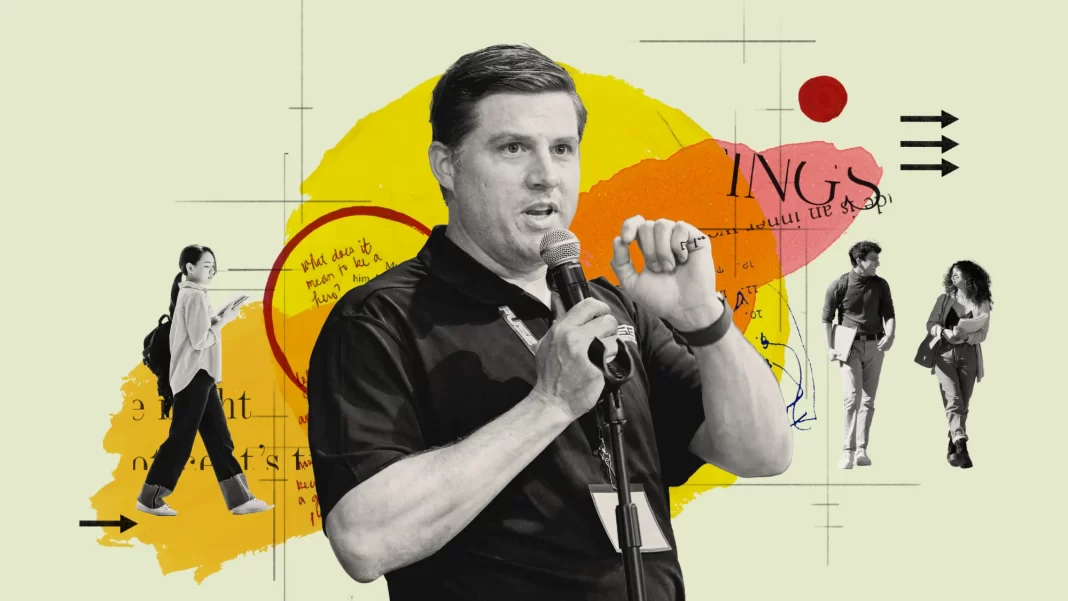Noted author and psychologist David Yeager on the common mistakes we make when giving feedback to students, and how to tap into purpose and belonging to make classroom work more meaningful.
David Yeager will never forget his first year of teaching middle school. Eager to make a difference in kids’ lives, he vacillated between feelings of optimism and helplessness. “I had come to the classroom mainly because I wanted to motivate, inspire, and engage teenagers,” he recalls, before sharing the frustration he felt when trying to connect with his kids.
At first, he thought that the trick to engaging students was to put on a good show—Robin Williams standing atop a desk giving a rousing speech—but it wasn’t until he taught The Outsiders to his seventh grade students that things started to click. After finishing the novel, he asked his students to use what they learned to create conflict resolution workshops for younger kids at the school. The shift in their attitudes was dramatic—his students went above and beyond, conducting research and seeking critical feedback to produce top-notch work. They were motivated because the work they were doing tapped into their sense of purpose. It mattered.
Yeager, who recently authored the book 10 to 25: The Science of Motivating Young People, emphasizes that such strategies seem like magic, but they’re not. Tedious tasks such as double-checking data in a spreadsheet may feel like a burden to students, but if those calculations are connected to real-life problems that kids care about—ensuring that local water contamination levels are low, for example—then students often rise to the occasion and demonstrate the discipline and hard work that’s commonly lacking with traditional assignments.
Now a psychology professor at the University of Texas at Austin, Yeager is on a mission to undo some of the big misconceptions we have about the teenage brain. Chief among them: The idea that kids are poor planners and goal-setters—when the incentives are right, in fact, kids are actually better at goal-directed behavior than adults. We’re just not putting the right tasks in front of them, or showing them the respect that their status as young adults warrants.
I sat down with Yeager recently to talk about what parental nagging actually sounds like to teenagers; how to adjust your teaching feedback so kids actually listen; and why school belonging initiatives often fall flat.
Youki Terada: David, what is it about the adolescent brain—that particular developmental stage—that makes motivating students so different and so challenging?
David Yeager: A common view is that young people can’t be motivated at all—or if they can, they’re motivated by short-sighted, selfish, hedonistic things like sex or drugs or getting likes on Instagram.
But the scientific view is that adolescents can be motivated, it’s just a different set of priorities. Those priorities revolve around experiences of status and respect, the feeling that they are viewed as a person of worth and significance by others whose opinions they care about.
And once an adult realizes that, then the trick is to frame desired behaviors—whether it’s eating healthy or not doing drugs or not smoking, or just doing your math homework—in a way that’s consistent with the core adolescent values of status and respect.
Terada: Sometimes we forget about that framing when we give feedback to adolescents. In your book you referenced a study that scanned the brains of teenagers when they were being nagged at by their parents.
Yeager: That’s a beautiful study. The researchers asked a very simple question that I’m amazed no one asked before: “What happens in the teenage brain when your mom is nagging you?”
So they had moms pre-record themselves completing the sentence, “What bothers me about you is . . .” and then they brought the teenage daughters in and had them listen to their mom’s actual audio finishing that sentence. Approximately 0% of teenage girls said, “You know what, Mom, you have a point. I’m really glad we had this chat and I’m going to change everything. So, thanks for the laundry list of my flaws.” So that didn’t happen.
Instead, what you saw was teenagers experiencing increases in blood flow signifying greater activation in regions of the brain related to anger and decreases in regions related to thinking and planning. So kids aren’t making a plan to change their behaviors, and they’re not spending any cognitive effort trying to understand what their mom really wants.
That tends to suggest that the communication styles we resort to when we’re at our most exasperated are the very conversation styles that undercut their motivation.
Terada: Bringing it back into the classroom, can you give some examples of how to align a teacher’s behavior or actions to this driving need for status and respect?
Yeager: A way to misalign communication is something I call an enforcer mindset. That’s where you’re setting impossible standards, and when teens don’t live up to those standards, you’re yelling and telling or blaming and shaming. That approach ends up making them feel humiliated and disrespected—it’s the opposite of respect and status, and it switches off motivation.
Another bad approach is lowering standards to the point that it’s clear to teens that we’re not really expecting anything of them. That’s what I call a protector mindset—a kind of soft bigotry of low expectations. That also comes across as really disrespectful. In the short term young people don’t mind if things are easy, but in the long run, they’re afraid that they’ll be unprepared for the future.
The thing that does seem to work really well is finding a way to communicate that teens can make a real contribution, that their opinions actually matter, and that you, as the adult, are going to walk that journey with them.
Terada: That can be tricky. You note that teachers often struggle with the “mentor’s dilemma.” What is the mentor’s dilemma, and how does that impact someone’s ability to teach and motivate students?
Yeager: The mentor’s dilemma is a term coined by Stanford professor Geoff Cohen. It’s the idea that it’s very hard to simultaneously criticize someone and motivate them—and it’s a dilemma because it seems like there’s no clear choice.
On the one hand, you could be hyper demanding and critical but crush their motivation. On the other hand, you could withhold your feedback and not say anything—but that doesn’t help them get better.
The way to resolve the mentor’s dilemma is to adopt the mentor’s mindset. Be honest and tough and critical, but make sure that your supports are high enough to help students live up to the standard of performance that you just demanded. The mentor mindset is saying: “This is hard, but it’s hard for a reason.” The approach works because it comes across as respectful: I, the adult with power in this situation, view you, the young person, as independent and able to determine your own future.
Terada: And you were beginning to think about the mentor’s mindset a decade ago when you tested your theory of wise feedback, it seems? What’s “wise feedback,” and why does it work for teens?
Yeager: I led one of the major papers that evaluated wise feedback—an idea developed by Geoff Cohen—and it was a study of seventh graders writing essays about their heroes, and the teachers covered the essays with feedback.
We looked at whether students would assume that a teacher’s critical feedback was coming from a good place. And what we found was that no, students didn’t trust that the teacher was on their side, especially students who felt they had been mistreated in terms of their discipline in the school. They viewed criticism on an essay as yet another sign of disrespect—that the teacher was looking down on them, being unfair, or being unjust. And because of that perception, students in general—and especially students of color—were less likely to revise their essays.
In our experiment, teachers appended handwritten Post-it notes to kids’ essays that clarified the intent of the feedback, conveying the teacher’s care and concern for the student, along with the idea that the teacher had high standards.
And so the note said, very simply:
“I’m giving you these comments because I have very high standards and I know that you can meet them.”
We found that the message doubled the rate at which students were willing to revise their essays, from 40 percent to 80 percent. That effect was especially strong for students of color.
Terada: Right, and similarly you’ve also studied “transparency messages,” which can help ease anxiety that students may feel when interacting with teachers. What are some examples of transparency messages for teachers? When should they be used?
Yeager: Transparency statements were developed by Kyle Dobson, who is now a professor at University of Virginia. It’s this simple idea that there’s often a power disparity between an adult and an adolescent, and the adolescent will, for various reasons, presume the worst—until the adult clarifies that they’re coming from a place of caring.
That’s important because, as teachers, we often think, “Well, of course every kid knows I’m critiquing them because I care for them. Of course they know that I’m maintaining discipline and order so that way they can learn and thrive.”
But we actually need to explain what we’re doing and why, and we can’t take that for granted because teens are so used to negative treatment in their daily lives.
Terada: OK, so your research clearly suggests that high-demand, high-support environments are ideal for teens—but there’s also the broader sense of “fit” and belonging, too. Why do you think belonging is so important?
Yeager: Well first of all, the desire to be accepted is a core human need. And when we don’t experience that, it’s very hard to muster the motivation to continue trying hard. Think about how hard it is to learn a new skill, to be confused and lost at the frontiers of your ability. If you’re not confident that the skill is for you, it’s easy to ask yourself why you’re doing it, and to eventually give up.
Terada: But you feel that some schools fundamentally misunderstand how to create a sense of belonging. Where do you think they fall short?
Yeager: What some schools get wrong is they try to declare belonging by fiat. They come up with a “You Belong Here” slogan and put it on a button or a T-shirt, and they assume that a student who is the first in their family to go to college—and maybe doesn’t look like anyone else on campus—is suddenly going to think, “You know what? I do belong in the hardest chemistry class because there’s a sticker with the school mascot jumping for joy and saying, ‘I belong.’” That’s not a realistic expectation.
Building on research by Greg Walton, Geoff Cohen, and others, we found what you need to do instead is to really understand why students feel like they don’t belong. Often it’s because they’re telling themselves a story about non-belonging that gets in the way. A better approach is to help them tell a better story in which non-belonging is normal at first, but tends to improve over time.
Terada: What about the importance of academic purpose for teens? What insights has your research uncovered on that topic?
Yeager: Purpose is critically important and it’s tragically understudied. One of the big research insights is that young people really do want to connect to something bigger than themselves. They’re not just trying to optimize skills to exchange for wages in the future; they want to feel a sense of meaning—but they hardly ever talk about it spontaneously, so adults make the incorrect assumption that kids don’t care about it.
When we surveyed teens, what we learned is that you can’t really tell a kid to have a purpose, or what their purpose should be, but you can ask them to reflect on their purpose more deliberately, and connect it with what they’re learning in school. And when you do that, adolescents construct their own mental narrative about purpose that helps them to stay engaged even when things are hard or boring.
Terada: What can teachers do to elicit a sense of purpose in teens?
Yeager: Ideally, your assignments are teaching skills that kids could use in the future for something that matters to them. But that doesn’t mean that every assignment needs to be a five-day project. There are a lot of lower- level skills that just need to be framed as part of the pathway of developing a stronger brain so that you can make a difference in the world.
You can’t assume that kids will spontaneously view entry level skill-building as meaningful; when kids write an essay, they’re not going to see how writing an essay about your hero is related to one day being a lawyer and arguing for the Supreme Court on someone’s behalf. That’s not obvious to them.
You have to do a little bit of cognitive bridging. Building on research from Chris Hulleman and Judy Harackiewicz, we found that you can do that by asking young people to tell you how they could use the skill they’re learning now to do something important in the future—if you ask them, they come up with very interesting answers that can be compelling to them.
This interview has been edited for brevity, clarity, and flow.





